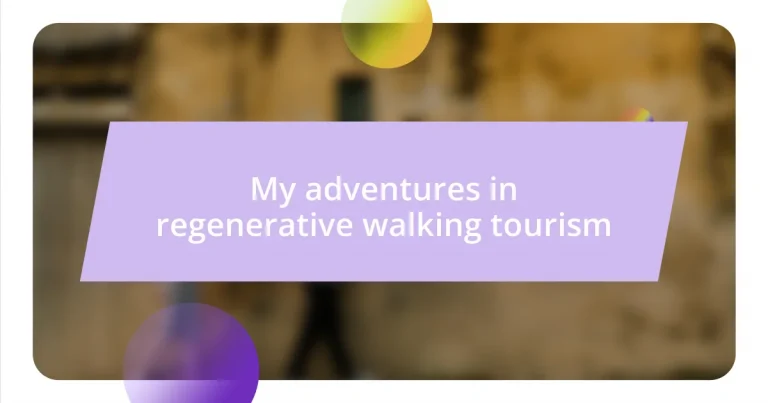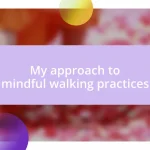Key takeaways:
- Regenerative walking tourism emphasizes the importance of connecting with local communities and ecosystems, fostering a sense of belonging and respect.
- Benefits include emotional connections, support for local economies, and personal transformations that inspire sustainable practices.
- Engaging with locals, practicing sustainability, and sharing experiences enrich both the traveler’s journey and the community’s heritage.

Understanding regenerative walking tourism
Regenerative walking tourism goes beyond simply exploring new landscapes; it’s about deepening our connection with the places we visit. I remember hiking a trail that led me through a small village, where the locals shared their stories of resilience amid climate change challenges. It struck me—how often do we pause to think about the communities behind the beautiful scenery?
When I reflect on this type of tourism, I see it as an act of restoration. It’s not just about what we take from a place, but how we can give back. For instance, joining a tour that supports local conservation efforts gave me a sense of purpose. I’ve found that tapping into the local culture and participating in environmental initiatives enriches our travel experience and helps sustain these places for future visitors.
Have you ever thought about how your hiking experiences could contribute to the environmental landscape? Engaging authentically with local ecosystems and traditions creates a positive feedback loop. I’ve witnessed the joy in local artisans’ faces when their crafts celebrate ancient skills, and it’s incredibly fulfilling to know my wanderings can support their livelihoods. This dynamic not only enhances my journey but also leaves behind a legacy of sustainability.

Benefits of regenerative walking tourism
The benefits of regenerative walking tourism are vast, and I’ve experienced them firsthand during my journeys. For me, one standout advantage is the deeper emotional connection I develop with nature and the communities I encounter. I remember hiking through an eco-village where the locals explained their unique farming methods while sharing a traditional meal with me. That experience wasn’t just about enjoying beautiful views; it was about feeling a part of something larger, fostering a sense of belonging and respect that I didn’t expect from a simple walk.
Another remarkable benefit is the boost to local economies. When I ventured on a walking tour that included local guides, I found that my dollars directly supported families in need. It’s heartwarming to know that my participation contributes to preserving their culture and environment. Having the chance to interact with artisans and farmers, I learned how tourism can be a lifeline, enabling communities to thrive without compromising their heritage.
Lastly, engaging in regenerative walking tourism allows for a personal transformation. I’ve often come back from these excursions feeling empowered to advocate for sustainable practices at home. Each story I collect along the way encourages me to inspire my own community toward more conscientious living. It’s fascinating how a humble walk can inspire change, not only in the traveler but in the interconnected web of life that we’re all part of.
| Benefit | Description |
|---|---|
| Emotional Connection | Deepens connection with nature and local culture. |
| Economic Support | Boosts local economies by supporting artisans and guides. |
| Personal Transformation | Empowers travelers to become advocates for sustainability. |

Planning your walking adventure
When I start planning my walking adventure, I like to consider a few key elements. It begins with choosing a destination that excites me and aligns with my values. After all, a place steeped in culture and ecological significance can make all the difference. I’ve often found that researching local customs and environmental challenges not only enriches my experience but also helps me to contribute meaningfully to the community’s story.
Here’s a quick checklist I follow to ensure a fulfilling adventure:
- Research the Area: Learn about the local culture and ecosystem.
- Engage with Locals: Reach out to community members or guides who can offer unique insights.
- Plan Sustainable Activities: Look for tours that support conservation efforts.
- Pack Mindfully: Bring reusable items to minimize waste.
- Reflect on Intentions: Consider what you hope to gain and give during your journey.
I’ve learned that flexibility is crucial. Last year, during a trip to the mountains, I adjusted my plans based on unexpected weather but ended up discovering a breathtaking hidden lake that wasn’t in any guidebook. These moments remind me that sometimes the best adventures are the ones that unfold naturally, guided by curiosity and respect for the land. Embracing spontaneity can lead to incredible experiences that you never could have planned for.

Choosing regenerative walking destinations
When selecting regenerative walking destinations, I always look for locations that prioritize sustainability and community wellness. For instance, I once wandered through a lush forest in a small village where the locals practiced reforestation. Their passion for preserving the land made my hike not just scenic but also a shared commitment to nurturing the environment. Isn’t it amazing how our choices can contribute to something bigger?
I’ve often found that engaging with local guides significantly enhances the experience. During a walk in a coastal town, my guide shared stories about the area’s marine biodiversity and the initiatives they had in place to protect it. This connection made me appreciate the beauty around me even more. It made me wonder: how can a simple story reshape our understanding of a place?
Additionally, I encourage you to consider destinations that allow for cultural exchange and learning. On a memorable trip to a mountain village, I attended a workshop where I learned traditional weaving techniques from local artisans. The knowledge exchange fostered a sense of kinship, reminding me how walking through sacred spaces connects us to both the land and its people. Reflecting on these experiences makes one realize the profound impact of choosing rightful destinations.

Engaging with local communities
Engaging with local communities is one of the most rewarding aspects of my walking adventures. I remember a trek through a quaint town where I decided to drop by a community gathering. The warmth of the people and their willingness to share their stories made me realize how vibrant local life can be. Isn’t it fascinating how a simple conversation over a cup of herbal tea can bridge cultures and foster mutual respect?
On another occasion, I participated in a tree-planting event organized by a local environmental group. This hands-on experience not only deepened my connection to the land but also allowed me to bond with community members who shared their hopes for the future. Their passion was infectious, and I found myself completely immersed in the moment. How often do we get to plant seeds—both literally and figuratively—in places we visit?
I also make it a point to support local artisans and businesses during my trips. While strolling through a market in a small town, I met a talented potter who invited me to her workshop. It was a joy to learn about her craft while creating something meaningful with my own hands. It struck me how these interactions enrich our understanding of a place and its people. Engaging with locals not only enriches my travels but also reminds me of the interconnectedness that defines our shared humanity.

Sustainable practices for tourists
When it comes to sustainable practices for tourists, my first step is always minimizing waste. During one of my walking tours, I stumbled upon a wonderful eco-friendly café that served meals on reusable dishes. I was surprised at how fulfilling it felt to enjoy a delicious meal while knowing I was contributing to a decluttering of our planet. It made me think—could this simple choice inspire others to follow suit?
I also try to prioritize public transport or biking whenever possible, as it truly transforms the way I experience a destination. On a recent walking trip, I rented a bike to explore a nearby town, and I found it exhilarating to breeze through the streets, taking in the sights and sounds at my own pace. I often wonder: has anyone else felt that rush of freedom that comes from leaving the car behind, enjoying the journey as much as the destination?
Moreover, I’ve learned the importance of supporting conservation projects during my travels. On one trip, I volunteered with a local beach cleanup initiative, and the satisfaction from seeing the beach transform before my eyes was unparalleled. It reminded me that every little effort contributes to something larger, igniting a connection with nature that I never knew I needed. Isn’t it empowering to realize that every tourist has the potential to positively impact the places they visit?

Sharing your experiences and insights
Sharing my experiences while on walking tours has become an extraordinary way to reflect on the journey. I recall a stroll through a vibrant market where I met a group of local chefs showcasing their traditional dishes. Our laughter mingled with the aromas, and I found myself scribbling notes in my journal, fully aware of how this moment would shape my understanding of authentic cuisine. Isn’t it incredible how such encounters can ignite our curiosity about food, culture, and history?
When I decided to share my adventures through storytelling, I discovered an unexpected ripple effect. A friend reached out after reading about my visit to a remote village, expressing how inspired they felt to plan their own trip. This realization struck me: sharing our insights is not just about recounting our journeys, but about encouraging others to embark on their personal quests. How often do we underestimate the power of our stories to spark inspiration in those around us?
Additionally, I often find that discussing insights gained from my travels adds depth to my connection with others. During a recent travel workshop, I shared my experience of walking alongside a local artist who painted the landscape as I captured it in words. The conversation that unfolded was rich with emotional undertones as participants recalled their own travel stories. It dawned on me that each person’s narrative has the potential to weave a tapestry of shared experiences, connecting us across distances. Do you see how these threads of connection can make our world feel smaller and more intimate?














